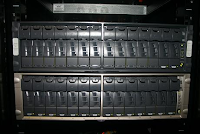
The list shows a number of interesting statistics. I am including some comments for changes observed from 2000 to 2007.
- Operating Systems. The stats show a significant change in 7-years. Unix went from 90-to-12 percent while Linux went from 5.60-to-77.80 percent.
- Processor Family. A significant change is apparent also where RISC-based technologies, namely IBM's Power, Sun's SPARC, MIPS, Alpha and PA-RISC, lost to the combination of Intel and AMD processor technology. The combined Intel and AMD offerings went from 4.00-to-78.80 percent.
The use of thousands of clustered Intel and AMD based servers for supercomputers may explain why tier-one vendors continue to devote much R&D and marketing to this segment. It may be regarded as a niche but apparently today it represents 19% of the server market and growing at 9% per year.
The industry seems to have found that there is much in common between the technology components needed for supercomputers and those needed by Google, Amazon, Yahoo, YouTube, Microsoft and others to power the growth in network-based services.
A key component that often calls less attention than real estate, power, storage, servers, OS and application software is the technology used to interconnect, to cluster, servers.
Core and leaf Switches and accompanying cables represent a huge expense, room, weight and computing capacity limiting factor.
Sun announced Constellation a system offering the building blocks around a connectivity technology that promises to simplify configuring supercomputers, should I say web services, scaling from tera-to-peta-flops.
The heart of Sun's Constellation is Magnum, a High-density 3456-port InfiniBand switch, that contributes to simplify the configuration and logistics for interconnecting large numbers of servers.
+------------- Top-500 Supercomputers ----------+
+------------- Number of Processors ------------+
Date Processors Count Share %
2007.June 1 1 0.20 %
33-64 3 0.60 %
65-128 5 1.00 %
129-256 2 0.40 %
257-512 81 16.20 %
513-1024 126 25.20 %
1025-2048 176 35.20 %
2049-4096 53 10.60 %
4k-8k 33 6.60 %
8k-16k 14 2.80 %
16k-32k 3 0.60 %
32k-64k 2 0.40 %
64k-128k 1 0.20 %
+------------- Interconnection Technology ------+
Date Technology Count Share %
2007.June Gigabit Ethernet 206 41.20 %
Infiniband 128 25.60 %
Myrinet 46 9.20 %
SP Switch 36 7.20 %
Proprietary 35 7.00 %
NUMAlink 15 3.00 %
Quadrics 11 2.20 %
Crossbar 10 2.00 %
Cray Interconnect 9 1.80 %
Mixed 4 0.80 %
+------------- Operating Systems ---------------+
Date OS Count Share %
2007.June Linux 389 77.80 %
Unix 60 12.00 %
Mixed 42 8.40 %
BSD Based 4 0.80 %
Mac OS 3 0.60 %
Windows 2 0.40 %
2000.June Unix 453 90.60 %
Linux 28 5.60 %
BSD Based 17 3.40 %
N/A 2 0.40 %
+------------- Processor Family ----------------+
Date Processor Count Share %
2007.June Intel EM64T 231 46.20 %
AMD x86_64 107 21.40 %
Power 85 17.00 %
Intel IA-32 28 5.60 %
Intel IA-64 28 5.60 %
PA-RISC 10 2.00 %
NEC 4 0.80 %
Sparc 3 0.60 %
Alpha 2 0.40 %
Cray 2 0.40 %
Intel + AMD 394 78.80 %
2000.June Power 143 28.60 %
Sparc 122 24.40 %
MIPS 62 12.40 %
Alpha 56 11.20 %
PA-RISC 53 10.60 %
NEC 25 5.00 %
Fujitsu 19 3.80 %
Hitachi SR8000 10 2.00 %
Cray 6 1.20 %
Intel IA-32 3 0.60 %
Intel i860 1 0.20 %
+-----------------------------------------------+








